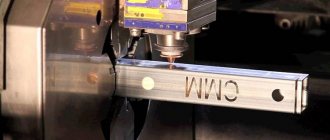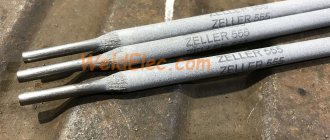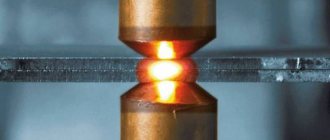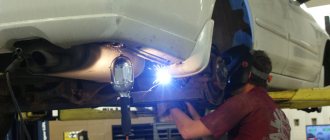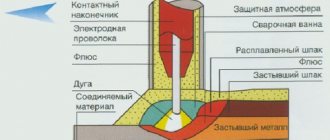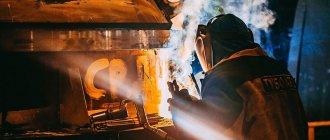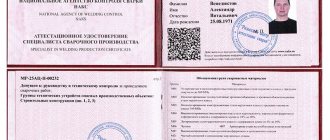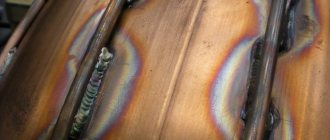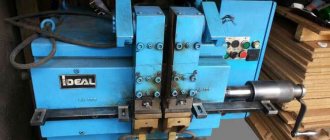Plastic welding is an effective way to lay polypropylene pipes and repair plastic products. A uniform seam is obtained by heating and melting. Special devices are designed for this. Anyone can learn to work with them. When choosing a technology, the advantages and disadvantages of each method are taken into account.
Welding plastic is the most economical technological method.
General information about welding thermoplastics
Connecting plastic parts by heating is a technology that has long been used in industrial settings and home workshops. The use of hot methods is only possible when working with materials belonging to the group of thermoplastics. This is the name for types of polymers that fully retain their characteristics after heating, melting and cooling. This is their difference from thermosets, which are destroyed by heating and final processing.
At high temperatures, such materials burn, while thermoplastics melt.
Suitable brands and selection rules
Cold welding for plastics is subject to less stringent conditions than welding for metal materials. The following brands have won leadership positions in the market:
- Poxipol is a two-component universal compound used for joining parts of different structures. Produced in two tubes contained in a cardboard package. Suitable for outdoor use at low temperatures. But such conditions affect the hardening period.
The mass can be applied in varying thicknesses. At the same time, cold welding will not spread or wrinkle.
The composition does not contain solvents, so it is safe for the body and is used in residential areas. Application requires careful cleaning of the bonded surfaces.
- Tytan is a cold welding, the base of which consists of epoxy resin with the addition of hardeners and plasticizers. Thanks to them, the hardening time is reduced to half an hour. The part can be put into operation within an hour. The operating temperature is -60 - +130 degrees, so Titanium welding is used for emergency repairs of devices and mechanisms that are designed to operate at elevated temperatures. Waterproof composition.
- Mastix is a multicomponent composition consisting of epoxy polymer, plasticizer, filler, and hardeners. When applying a thin layer, hardening occurs in 7 minutes. Operating temperature -60 - +200 degrees. It efficiently glues not only plastic, but also metal elements.
Cold welding grades Moment Super Epoxy, Skol, Almaz, Secunda are also widely used.
When choosing a material, attention is paid to the operating temperature so that the weld can withstand bonding. If the work is intended to last for a long period of time, then it is better to buy a composition with a quick, strong setting, which will significantly reduce repair work.
Types of plastic with weldability characteristics
The joining method is chosen in accordance with the type of polymer and its characteristics.
They are distinguished by high weldability:
- Polyethylene. Products made from such plastic are joined by melting the edges, which are then combined under pressure to prevent deformation.
- Polypropylene. The material is used in the production of pipes, which are connected using a 1500 W electric soldering iron. By increasing the temperature at the junction, the 2 elements are tightly fastened. The properties of the material help to obtain a seam that does not allow moisture to pass through.
- Polyvinyl chloride (PVC). Plastic does not deform when heated. The welded joint is strong and uniform.
Polypropylene is a synthetic thermoplastic non-polar polymer.
The following polymers have medium or low weldability:
- Polystyrene. The polymer is used in the manufacture of dishes, toys, and household items. Parts made from this polymer have rather poor weldability and require careful preparation.
- Polyvinyl chloride. It is not recommended to use hot methods when comparing elements from such a polymer. This is explained by the possibility of edge deformation, which impairs the quality of the seam. Cold methods are more effective.
We recommend reading: Which soldering iron is the best for PPR pipes?
VINYPLASTIC (PVC) SHEETS. WELDING OF PVC SHEETS.
Viniplast (unplasticized polyvinyl chloride, UPVC or simply PVC) is a material that is a rigid thermoplastic mass with a structure that does not transmit light. It is used in construction, chemical, automotive, instrument making and other industries.
The main components of vinyl plastic
The production of the material in question is accompanied by mixing PVC with perchlorovinyl resin, modification substances, and fillers. In order for the fabric obtained at the end of the production process to be processed with devices available to home craftsmen, the prepared raw materials are supplemented with a small amount of lubricating compounds. The role of the additive, which changes the properties of the final product in the direction desired by the manufacturer, is played by rubber or chlorinated polyethylene. The amount of this ingredient should be 35 percent. The polymer also contains 20 percent filler, which is represented by soot, chalk or aerosil. Additionally, at least ten percent of plasticizing and modification additives are present. The first type of these substances helps to reduce the cost of completely finished products, and the second one helps to significantly improve its technical characteristics. Antioxidants and stabilizers extend the service life, preventing the destruction of plastic during processing. Dyes allow you to give a product a certain shade.
Methods for producing PVC sheets
When forming vinyl plastic (PVC) products, the raw materials are subjected to compression by a pressing device, passing through an extrusion machine, and casting using high pressure. The method used for producing uPVC products is controlled by the type and purpose of the product:
- Parts with complex geometric shapes and large dimensional parameters - vacuum sheet formation.
- Canvases with non-rough surfaces - compression of packages consisting of vinyl plastic film using a pressing device.
- Film coatings - rolling of unplasticized polyvinyl chloride.
- Small products with a variety of shapes - compression of powders or tablets, casting from granules under significant pressure.
Dimensions and weight of PVC
The low weight parameter makes it possible to transport sets of vinyl plastic sheets in passenger cars. For products measuring 600x1500x2 mm it is approximately 2.8 kilograms, and 1240x2420x20 mm - 96 kilograms. Stores offer vinyl plastic sheets in sizes 600x1500, 650x1500, 670x1500, 700x1500, 750x1500, 1240x2420 or 1300x2000 mm. If a surface with a non-standard configuration is subjected to finishing work, an individual size is ordered from the manufacturer. Other services include uPVC cutting, parts creation, kit packaging, delivery to site and so on.
Joining vinyl plastic sheets (welding PVC sheets)
Vinyl plastic (PVC) welding is carried out in one or three ways:
- Welding with hand-held hot air devices (welding guns)
- Welding with manual welding extruders
- Welding on butt welding machines
General principles of welding PVC (vinyl plastic) sheets with hand tools (hair dryers and extruders):
Before starting work, the material is cut into pieces of the required sizes. Additionally, a milling cutter removes a chamfer, the size of which is controlled by the thickness of the sheet being processed. If the latter is 5 mm, the opening seam is tilted 55–60 degrees. When the thickness exceeds five millimeters, the angle increases to 70–90 degrees. The chamfer must be removed evenly along the entire length of the product. The seams formed during the build-up of the vinyl plastic coating lose their optimal strength and elasticity under the influence of oxygen. Therefore, the sheets must be welded in an inert gas. This option can be used when combining products with each other, renovating premises and some other events. But the processed material is irreversibly deteriorated by the temperature of combustible gases, which goes beyond the permitted parameters. To fill the resulting seam, it is allowed to use filler rods. They should be heated together with the parts to be combined. The coolant, represented by carbon dioxide, air or nitrogen, is heated by a special burner that consumes the energy of gas fuel or electric current. In the first version of the mentioned device, the coolant directly (direct contact) or indirectly (through the wall) receives the required temperature with the help of fire generated by the burning gas. In the second option, tubular electric heaters (TEHs) powered by electricity are traditionally used. When the temperature reaches 80 degrees above zero, the structure of the heated vinyl plastic undergoes softening. If it is 180 degrees, the product gradually flows. And 200–220 degrees of heat make the polymer viscous, causing its sheets to weld together under the influence of additional pressure. The strength of the seams is controlled by the volume and degree of heating of the supplied air masses, the diameter of the welding rod and burner nozzle, as well as the thickness of the joined sheets. It is recommended to select the nozzle diameter indicator based on the thickness of the sheets being welded, the outline of the edges and the size of the rod used for welding. When its value differs from the identical characteristics of the welding rod, heating of the latter will become more difficult and the quality of the formed joints will deteriorate. If sheets with a thickness of 3–5 millimeters are welded, the burner nozzle should have a diameter of approximately 1.5–2 millimeters. When connecting products with a thickness of 16–20 millimeters, the tip dimensions increase to 3.5–4 millimeters.
Welding vinyl plastic (PVC) sheets on butt welding machines
In this case, the welding process is practically no different from the similar process of welding polyethylene or polypropylene sheets. However, it is worth considering that welding PVC is a much more complex process associated with a reduced “welding window” of temperature.
PVC (vinyl plastic) is a polymer material that is difficult to weld and requires specific skills to work with.
SSPL company specialists are ready to conduct a master class on welding PVC sheets on butt welding machines produced by SSPL to ensure the best result.
Our catalog presents all types of equipment for welding vinyl plastic (PVC) sheets:
- Welding guns for welding vinyl plastic
- Welding extruders for PVC welding
- Butt welding tables for PVC (vinyl plastic)
Hot welding methods and necessary equipment
The following tools are used to connect plastic elements by heating:
- manual units that produce a stream of hot air;
- extruders;
- devices for joining sheet polymers;
- automatic welding units.
A plastic welding hairdryer can be used to join any thermoplastics.
To choose the right thermoplastic welding tool, you need to study the operating principles, advantages and disadvantages of each device.
Handheld hair dryer or gun
Together with such equipment, a consumable material is used - a rod, which is placed between the elements to be connected. After this, the seam is heated with a construction hairdryer. The device resembles a household appliance used for drying and styling hair. The temperature and power of an industrial hair dryer are higher. Thanks to this, the edges of the elements being welded are melted, forming a homogeneous mass. As it hardens, it holds the parts together.
The temperature of the air stream is adjusted automatically or manually. The kit includes attachments that help connect plastic elements end-to-end or overlapping. The nozzle configuration is selected depending on the type of plastic, the thickness of the parts, and the experience of the welder.
Household hair dryers are used to perform routine operations. Industrial options are designed for laying polymer pipelines.
Extruder
The device is similar to a gun, at the end of which there is a nozzle for fixing a filler rod or tube.
An extruder is a machine for continuous processing of polymer raw materials.
The operating principle is based on:
- heating the consumable to a semi-liquid consistency;
- removing mass to the junction of parts;
- solidification of the melt followed by the formation of a seam.
Using an extruder, you can weld elements of any thickness in one pass. The performance of the device is higher than that of a hair dryer. The main disadvantage is the inability to weld products made from different types of plastic. This is due to the difference in melting temperatures. Before starting work, the edges of the parts are cleaned of traces of dirt and grease that can impair the quality of the seam.
We recommend reading: How to solder a cooling radiator yourself
contact welding
The equipment produces short-term heat pulses applied in combination with pressure. The devices are used at production sites where welded polymer sheets are produced.
Welding with a soldering iron
An ordinary electric soldering iron is also suitable for bonding film at home. It is best to put a tip with a student or poster pen made of metal on its sting. If the polymer is burned through, the tip is slightly moved from the tip of the device - this reduces the heat transfer area.
Soldering is more reliable if you attach special rollers to the soldering iron. The tip is ground off until it stops, a groove is cut in the center of the end, for which a hacksaw is used. You will need a copper disk with a diameter of 1 cm (those who are serious about building such a device can grind it themselves).
Drill a hole with a diameter of approximately 5 mm to attach the axle, insert the disc into the slot made and secure it. It should rotate freely. To ensure an even weld, guide it along a ruler. The device must be guided to the point where the seam ends, without tearing it off, with pressure. This approach is most often used for sealing bags. To get a beautiful seam, practice a little on unnecessary pieces.
Gas welding
This option refers to thermal methods of joining plastic products.
How to choose gas for hot welding
Oxygen or argon is often used as a heat source. However, the most economical gas is considered to be air, which does not have a negative effect on plastic.
Oxygen, hydrogen or argon are used as welding gases.
Ultrasound method
The universal method of heat welding involves local heating of the joint to a temperature close to the melting parameter. The dosed thermal effect does not contribute to overheating and deformation of the material, which is sometimes observed when using other methods. The equipment operates with a frequency of 17-45 kHz.
Electrical vibrations turn into mechanical vibrations, which are transmitted to the material being processed.
High frequency welding
The economical method is used in many industries. Welding is carried out using 2 metal electrodes, between which a current with a frequency of 30-75 MHz circulates. A high-frequency electric field heats the edges of the parts to the required temperature. After matching, the edges are cooled naturally. The method is suitable for connecting elements with a thickness of 0.5-2 mm. In this case, 2 welding methods are used: overlap or butt.
High-frequency welding is a pressure welding method in which the edges of parts are heated by current.
Friction method
Strong friction contributes to the release of thermal energy, which partially melts the edges of the parts. Compression under high pressure leads to the formation of a uniform, strong seam. The main advantage of the friction method is high productivity. The disadvantage is that it can only be used for welding hard types of thermoplastics.
Using a laser
Due to its high cost, this technology is rarely used in domestic settings.
In industry, the laser method is used for:
- assembling cars on automated lines;
- production of electronic devices, which requires careful handling of small plastic parts;
- manufacturing of medical instruments and devices where it is necessary to create sterile conditions;
- packaging of meat and dairy products.
The laser method helps to weld structures of complex configurations. Other methods in this case are ineffective.
Surface dissolution
A simple technology is based on chemical melting of the edges followed by fixation under pressure. Heat can be used to speed up operation. The main disadvantage is the toxicity of the substances used in the work. The method is not recommended for use at home.
We recommend reading: Heating temperature of polypropylene when soldering pipes
Hot gas
Gas welding of plastic means that a directed flow of hot air or industrial gas - argon, nitrogen and others - is used to soften the material. In domestic conditions, air is usually used, and the tool for supplying it is a hair dryer.
The temperature of the supplied gas should be approximately 80-100 ° higher than the temperature of viscosity, that is, softening of the welded metal to the desired condition. Under these conditions, it is also necessary to ensure pressure on the plastic edges being joined. To do this, you can use a pressure roller, which is moved along the seam following the hair dryer (the help of another person is required), or special fixing attachments for the hair dryer.
This attachment allows you to compress the surfaces during welding. Specially for processing large-format sheets - banners, awnings, blood elements - crevice and forming attachments have been developed for a standard industrial hair dryer (heat gun).
In industry, a special gas composition is more often used to ensure the absence of oxides in the weld, which weaken its structure. In everyday life this is not critical, since the load on plastic parts is usually insignificant.
Gas heating imposes a limitation on the thickness of the material being welded - no more than 2 mm. Optimal - 1.5 mm .
Gas welding of plastic can be done either without the use of filler material or with an additive. The role of the additive is played by the so-called electrodes - rods made of plastic of various brands (selected based on the brand of plastic), with a diameter of 2 to 6 mm.
Calling them electrodes is not entirely correct. No current flows through them during gas welding (almost all plastics are dielectrics). But the name stuck simply by analogy with metal welding.
The use of an additive can increase the strength of the seam and deepen the weld. This method is suitable for fastening thicker parts. It is possible to either manually feed the additive with rolling or use special equipment - an extruder, an extrusion gun.
Selection of welding rods
These elements play the role of electrodes. They are used for soldering sheet plastic, pipes, and polyethylene objects. The size of the rods varies, as does their shape. The diameter of round bars is 3-7 mm. Rods with a square cross-section are large in size.
Plastic welding rods can be made from a wide variety of materials.
To connect polymer products, 2 types of consumables are used:
- Polyethylene rods. They have a fairly low melting point. Used for welding products made of the appropriate material using a hair dryer.
- Polypropylene rods. The elements do not deform and do not lose their working properties during long-term storage. The products are used in the assembly and repair of structures made of sheet polypropylene. Electrodes made of this material are used in conjunction with extruders that melt them to a liquid state.
Selection rules
When choosing adhesive for plastic, you need to pay attention to the following criteria:
- Operating temperature. If the item will be used in extreme conditions, the adhesive seam must withstand both high and low temperatures.
- Permissible pressure on the seam. The indicator is indicated on the packaging by the manufacturer. If the glued plastic is subjected to higher loads than allowed by the instructions, the connection will break.
- Freezing time. If the item needs to be repaired for a long time, the gluing mixture must have a long hardening time. For gluing small parts, 3-5 minutes per coupling is enough.
- Release form. For gluing thin plastic elements, it is better to use a liquid substance, and it is more convenient to carry out rough work using thick plasticine-like welds.
Which method is better for home use?
The following technologies are most often used in everyday life:
- Welding with a soldering iron. The tool has a low price, which allows it to be used even for the simplest operations. A soldering iron is used to weld pipes, containers, and car bumpers. The tool melts the surfaces at the joint, which are then matched and fixed. This method can be used to connect pipes of different diameters.
- Gas welding. At home, use a hairdryer or burner. The heated gas melts the plastic, which helps form a uniform seam. An inexpensive welding tool helps you join plastic parts of different shapes and sizes. It is used in the repair of thin-walled polymer products. The process is carried out with or without the use of filler material. Plastic rods or strips are used as consumables.
- Extruder connection. The gun is equipped with a heating element that melts the consumable material. The equipment is also equipped with a regulator that helps change the exposure temperature. Heat losses are minimal, which explains the high efficiency of the equipment.
Application area
The rapid development of industry using plastic materials has provoked the popularity of cold welding adhesive.
Main areas of use:
- Repair of plastic casings of technical products;
- Alignment and gluing of car body parts;
- Repair of fishing gear;
- Setting up sewer systems;
- Connecting plastic parts and assemblies.
Cold welding adhesive is used not only for joining plastic, it also firmly connects metal structures, wood, and other materials.
